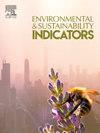Escalating climatic and anthropogenic disturbances drive a fragmented and squeezed vegetation pattern: a case study in the yellow river Delta from 1990 to 2020
IF 5.6
Q1 ENVIRONMENTAL SCIENCES
引用次数: 0
Abstract
Vegetation in saltmarsh wetlands provides critical ecosystem services, including carbon sequestration, coastal protection, and biodiversity maintenance. Both natural processes and human activities, however, have caused significant vegetation degradation. Despite growing concerns, the long-term dynamics of landscape patterns and the causal pathways underlying these changes remain poorly quantified. In this study, a framework is constructed that integrates eight landscape pattern indices. This framework is applied to investigate the spatiotemporal pattern of saltmarsh vegetation in the Yellow River Delta (YRD), China, and their causal mechanisms from 1990 to 2020. Results revealed that the vegetation degraded by 65.15 % over the past three decades (10.79 km2 yr−1), as characterized by decreasing distribution area, squeezing distribution range, and fragmented landscape patterns. Impact of climatic factors shifted from negative before 2000 to positive after 2005, while human activities consistently imposed the direct negative pressures on vegetation landscapes. Both climate and human activities indirectly altered soil properties such as soil organic matter and total phosphorus, exacerbating negative effects on saltmarsh vegetation, particularly after 2000. These impacts of natural and anthropogenic factors on saltmarsh vegetation showed strong spatial heterogeneity. Climate and human activities exerted widespread effects across the YRD, whereas soil properties impact saltmarsh vegetation locally. The findings highlight the complex interactions among various drivers and multiple causal pathways inducing alteration of vegetation landscape patterns. Targeted and localized management strategies are urgent for policymakers and environmental managers to achieve effective vegetation conservation and restoration in coastal wetlands.
不断升级的气候和人为干扰驱动了破碎和挤压的植被格局:以1990 - 2020年黄河三角洲为例
盐沼湿地的植被提供了重要的生态系统服务,包括碳封存、海岸保护和生物多样性维持。然而,自然过程和人类活动都造成了严重的植被退化。尽管人们越来越关注,但景观格局的长期动态和这些变化背后的因果途径仍然难以量化。本研究构建了一个整合8个景观格局指数的框架。应用该框架对1990 - 2020年黄河三角洲盐沼植被时空格局及其成因机制进行了研究。结果表明:近30 a来,植被退化率为65.15% (10.79 km2 yr−1),表现为分布面积缩小、分布范围压缩、景观格局破碎化;气候因子对植被景观的影响由2000年以前的负向正向转变,而人类活动对植被景观的直接负向压力持续存在。气候和人类活动都间接改变了土壤的性质,如土壤有机质和全磷,加剧了对盐沼植被的负面影响,特别是在2000年以后。自然和人为因素对盐沼植被的影响表现出强烈的空间异质性。气候和人类活动对整个长三角地区产生了广泛的影响,而土壤性质对盐沼植被的影响则是局地的。这一发现强调了导致植被景观格局变化的各种驱动因素和多种因果途径之间的复杂相互作用。为了有效地保护和恢复滨海湿地的植被,决策者和环境管理者迫切需要有针对性和本地化的管理策略。
本文章由计算机程序翻译,如有差异,请以英文原文为准。
求助全文
约1分钟内获得全文
求助全文
来源期刊

Environmental and Sustainability Indicators
Environmental Science-Environmental Science (miscellaneous)
CiteScore
7.80
自引率
2.30%
发文量
49
审稿时长
57 days
 求助内容:
求助内容: 应助结果提醒方式:
应助结果提醒方式:


